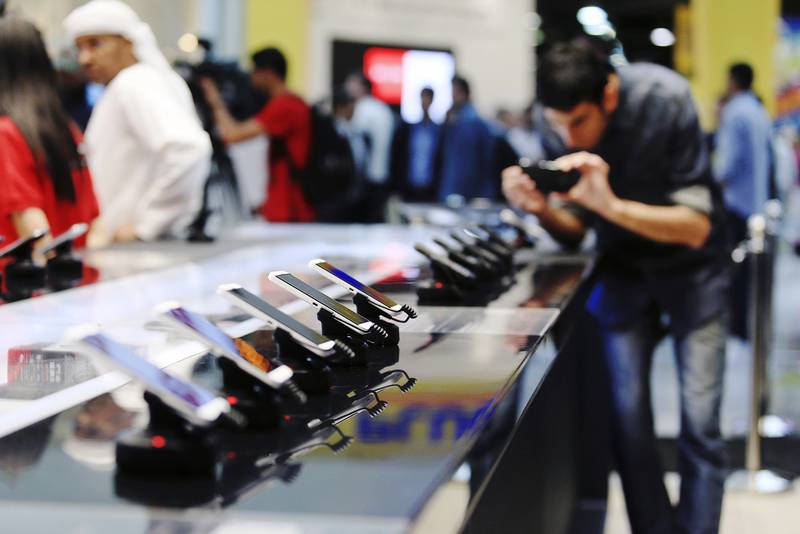Smartphone industry to face headwinds from supply chain disruptions in 2022

The global smartphone industry will continue to be hamstrung well into the next year by supply chain disruptions and component shortages, with the Omicron variant further exacerbating the situation, according to the industry experts.
In wake of the lower-than-expected third-quarter performance and the continued logistical challenges, International Data Corporation has lowered its growth forecast for this year and next to 5.3 per cent and 3 per cent, respectively from 7.4 per cent and 3.4 per cent.
There is no respite in the short term either for the industry and the situation is not expected to improve until mid-2022, Ramazan Yavuz, senior research manager at IDC for Middle East and Africa region, told The National.
The concerns that the latest Omicron variant may lead to further disruptions in manufacturing and logistics “scenarios that point to the last quarter of 2022 to speak of an end of supply chain disruptions are gaining in weight”, said Mr Yavuz.
Global sales or shipments of smartphones are expected to reach 1.35 billion by the end of this year and slightly more than 1.39 billion by the end of 2022, the Massachusetts-based researcher predicted.
“The smartphone industry will continue to navigate out of supply chain issues in the first half of next year. Industry wide component shortages will prevent market from hitting the double digit growth [in 2022],” Edward Moya, senior market analyst for the Americas at New York-based Oanda, told The National.
“The Omicron variant could wreak [further] havoc on supply chain disruptions in the first quarter … the fight against Covid isn’t over and inflationary pressures could lead to higher prices for the industry,” said Mr Moya.
Global smartphone sales to end-users declined 6.8 per cent in the July-September period, compared to the same period last year, according to Gartner.
Component shortages disrupted production schedules, leading to lower inventory and delayed product availability, which eventually impacted sales to end-users, the Connecticut-based technology research and consulting company said.
“In 2022, we do expect sales to improve but it is not really going to be in a double-digit – probably around 8 per cent … we may still be slightly behind to achieve that 2019 level [pre-Covid levels],” Anshul Gupta, senior director at Gartner, told The National.
Mr Gupta said although the Covid-induced disruptions have started to really normalise on both fronts – chip-related shortages and supply constraints – but the situation is far from resolved.
“We expect the situation with regard to some of the key components especially the chip sets will likely continue until the second quarter of next year,” he added.
In the third quarter of this year, Samsung maintained its lead in the smartphone sales, though its overall market share declined 1.9 per cent on an annual basis.
The South Korean brand sold more than 69 million smartphones in the third quarter, grabbing a market share of 20.2 per cent. Its sales declined more than 14.6 per cent on an annual basis.
Cupertino-based iPhone manufacturer Apple, which occupied the second spot, saw a 19.3 per cent annual jump in its sales to more than 48.4 million units. It took 14.2 per cent of market share.
The US company was followed by Chinese electronics manufacturer Xiaomi that controlled 13 per cent market share, selling over 44.4 million smartphones in three months to September 30.
The component shortage is expected to affect those who are more “heavily concentrated” on the 4G devices than the 5G, experts said.
“The overall state of access to critical components is in varying degrees by each smartphone brand. Some budget phone makers have relatively better access to supplies, and they will be less affected compared to the competitors even in the same segments,” said Mr Yavuz.
Premium brands, too, will face challenges stemming from component shortage and logistics, according to Mr Yavuz. However “lessened consumer confidence due to increasing inflationary pressures" and an improving line-up of mid-range phones are the major challenges that premium phone makers could face next year, he said.
However, Mr Moya predicted that 2022 should be the year of budget phones as more consumers steer clear of premium phones. Apple, though, might gain market share due to the high popularity of iPhones among users, he added.
Still, it is difficult to predict, Mr Gupta said.
“It is quite complex globally,” he added.
“When we look at countries like China, the US or some in Europe … smartphone penetration is almost between 80 and 98 per cent and 5G is already deployed … in those markets, it will definitely be the premium smartphone makers gain and 5G will be the key.
“However, for the other markets for instance Latin America, Africa or emerging Asia-Pacific … 5G may not be there in all of the markets. For example, India is a big market but 5G is still yet to be auctioned. So, I would say in these markets, it will be a mix of the basic smartphones which will be costing anywhere between $150 to $300, including lower-end phones closer to $100,” added Mr Gupta.
Foldable smartphone technology will also add to the industry growth in 2022 and beyond, experts said. Their shipments will surge nearly three times on an annual basis to about 9 million units this year, with Samsung accounting for 88 per cent of the market share, according to Hong Kong-based Counterpoint Research.
By 2023, foldable smartphone shipments are expected to grow tenfold. Samsung will continue to rule the industry with about 75 per cent of market share, the market research company said.
Companies such as Huawei, Lenovo and Motorola are also selling their own foldable phone models, while Apple is expected to launch its first foldable phone in 2023. It has developed prototype foldable screens for internal testing but has not solidified plans to actually release a foldable iPhone yet.
